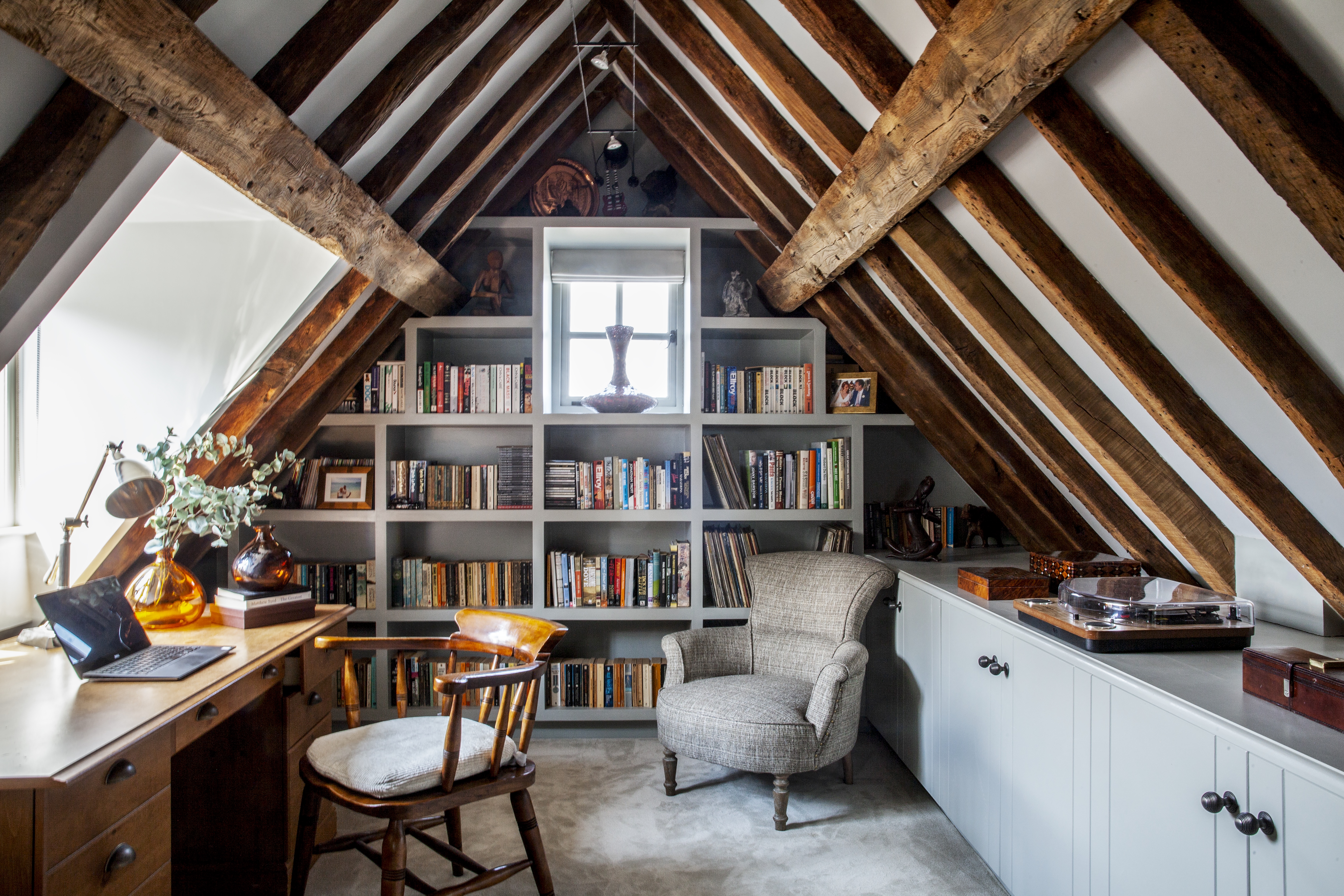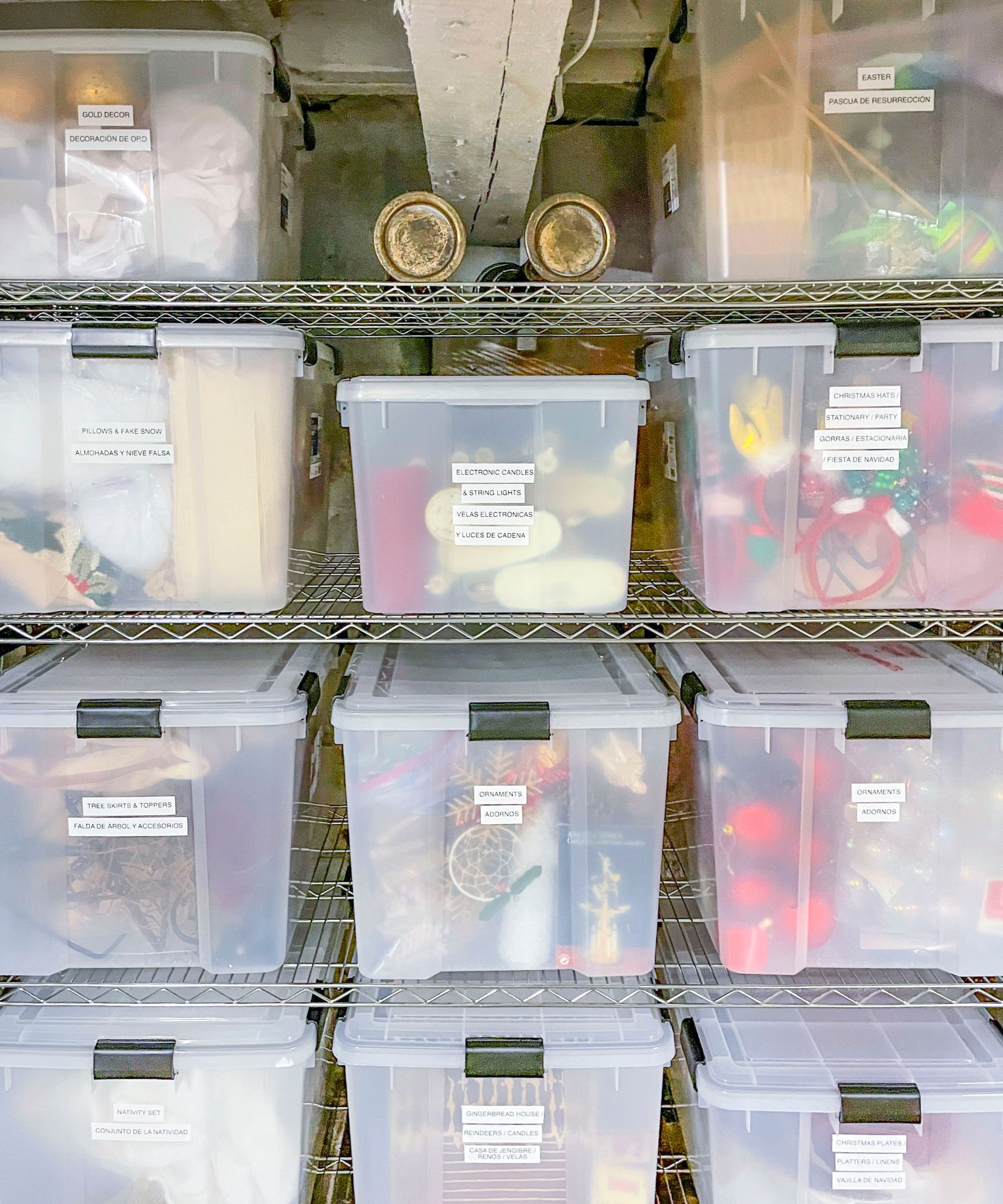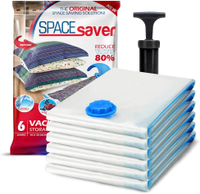How to organize an attic when you downsize – tips and tricks from the experts
'Remember; if you haven’t used it or seen it, you haven’t missed it'

Downsizing your home can feel scary, but it's also an exciting opportunity to live more simply, with less clutter, and essentially, less house to maintain. But if you’re moving from a bigger property to something smaller, it’s important to consider how you’re going to organize spaces that tend to be full of ‘stuff’ – such as our attics.
Attics can turn into somewhat of a dumping ground as the years go by, becoming a catch-all spot for anything we don’t want to, or can’t, put elsewhere. This means that they often hold everything from luggage, to photographs, to out-of-season clothing, sentimental items from our past, or even broken or disused items.
As such, getting this space in shape when you downsize is imperative, as downsizing often equals less space for clutter and an increased need for home organizing ideas. But don’t look at this process as a negative; as with organizing a kitchen when downsizing, organizing your attic when you downsize is a chance to really utilize the space, to ensure that everything inside is something you either really use or treasure; and, that you can find easily.
How to organize an attic when you downsize

Our attics may be prime storage spots, but that doesn't mean they should be cluttered and messy.
If anything, it's important that this space is streamlined and tidy, with all your items easily accessible; because let's face it, rooting around in a dark, smelly attic for hours trying to find something isn’t anyone's idea of fun.
So whether you've just downsized and are wondering how to organize your attic now for a functional, easy-to-use space, or are making a plan for when you do move, these are the tips and tricks from professional organizers you'll want to bear in mind.
1. Make a plan for this lengthy job
Whether you’re downsizing or not, organizing an attic can be incredibly overwhelming, Wendy Trunz, Partner and Head Organizer at Jane’s Addiction Organization explains. 'This is not only because of the number of items that have been placed up there but because of the number of sentimental pieces and memorabilia that will likely have been stored there for years.'
As such, figuring out when and how you’re going to tackle this job is essential. First of all, decide whether organizing is something you want to do before you move to your new home, or after.
Secondly, set aside time to organize. The attic can often be a huge space full of items, so it makes sense to assign at least a few days to the task – in fact, this is one of the biggest pro tips when it comes to decluttering when downsizing.
'For most people, a full attic cannot be finished in a day if you are alone,' Wendy says. 'If you've already done a little bit, take note of the time spent on it so far, and what you achieved, so you can plan how many more hours or days it may take. Schedule that time into your calendar, so that you know it will get done,' she suggests.
Finally, tackling your attic section-by-section can often be helpful. Wendy says, 'The best way to begin is to choose a corner and work your way around all four walls. If you don’t even have a path in the middle, simply begin where you are standing, and start by making a path down the center.'
Wendy Trunz is a Partner and Head Organizer at Jane’s Addiction Organization based in Port Washington, NY. From organizing clients’ homes and offices to staging homes for sale and concierge moving services from inception to completion, Wendy works with clients to get them to love their spaces.
2. Remember that letting go of things will be essential
As any professional organizer will tell you, the key to organizing most spaces properly is first to start with a good declutter – and nowhere is this more essential than in an often-overstuffed attic. 'As you go through your attic, you are going to be dealing with old clothing, toys, furniture, memorabilia, photo albums, artwork, books, holiday decorations, etc. from, most likely, the past couple of decades,' Wendy points out.
Because of this, you'll probably need to get rid of a substantial amount of items, especially if you are downsizing from a home with a bigger attic, to a property with a smaller attic space.
'If you are downsizing and wanting to go from overwhelmed to overjoyed, you *must* let go of things. Remember; if you haven’t used it or seen it, you haven’t missed it,' Wendy says.

To make things as easy as possible, it's advisable to try and complete the decluttering process before you leave your current home. In fact, this is one of the best decluttering habits professional organizers suggest when downsizing. This will save you from having to move items you don’t want to your new property; which could, in turn, save you some much-needed cash in removal fees.
You should also try and be as ruthless as possible when organizing practical items in your attic, during the downsizing process. 'Many people store things like old furniture, paintings, or lamps in their attics. And too many years go by with attics filled because of the feeling, "someday I might need it, or my kids will want it." Now is the perfect time to find out if that's true,' Wendy says.
'If you aren’t using them, it’s time to either bring them down into your home and start using them or let them go.'
3. Have a 'party' for your unwanted items – especially sentimental pieces
With the above in mind, if you are downsizing, consider that it may even be time to declutter sentimental items, even if it is difficult emotionally. 'This may sound harsh but the reality is that if you do not do these things (cull your collection of sentimental items) someone will have to do it when you're gone,' Diane N. Quintana and Jonda S. Beattie, owners of Release Repurpose Reorganize, say.
If you are holding onto sentimental items that you don’t know what to do with – such as items from deceased relatives – it can be really cathartic (and helpful) to hold a 'party' of sorts, to facilitate their move to a better home with your loved ones. In fact, this is one best decluttering tips for dealing with items you haven't touched, or even seen, in years.
'For sentimental items that you don't want to keep, we suggest having an open house party,' Diane and Jonda say. 'Have your friends and neighbors over, provide snacks, and tell everyone to go home with something. As they are looking at the items, tell them the stories of what the things mean to you – where they came from, who had them before you.
'The telling of the story and transferring the item to someone you know can make it easier to part with things – particularly if you know they like the item and will use it.'

Diane N. Quintana and Jonda S. Beattie have been working together for almost 14 years as professional organizers. They work together with clients in their homes, give professional organizing workshops, and presentations together, and have also written their own professional organizing books. Diane’s is: Now What? a Simple Organizing Guide. Jonda’s is: From Vision to Victory. Together, they recently published the best-selling book: Filled Up and Overflowing: what to do when life events, chronic disorganization, and hoarding go overboard.
4. Refrain from storing certain items in your attic

Our attics can sometimes feel like the go-to spot for items we don’t know what to do with. But if you’re organizing your space when downsizing, you unfortunately no longer have the luxury of being able to throw anything and everything into this room. Instead, now is the time to be intentional about what you store in your attic.
To make this decision a little easier, it’s worth noting that there are some things you should never store in the attic if you want to keep them in the best condition possible.
Professional organizer Jan Arkwright, president of Before & After Organizing by Jan explains that certain items can be vulnerable to degradation in your attic. 'Photos, electronics and art are more sensitive to temperature swings and humidity. As such, they should ideally be in closets, or areas of the home that are more temperature consistent than your attic.'

Jan Arkwright is an organizing professional who left her job as an attorney to start her own organizing business in 1997. Before & After Organizing by Jan LLC offers custom, sustainable solutions to help you reach your organizing goals; whether it be managing paperwork, eliminating clutter, or better space utilization. Jan is also a member of the Institute for Challenging Disorganization and a Golden Circle Member of the National Association of Productivity and Organizing Professionals.
Diane and Jonda also explain that while storing sentimental items in your attic might feel logical, it really isn’t the best place in which to appreciate them.
'If you're keeping things that tug at your heartstrings, keep them somewhere you can see them and honor them, rather than in the attic, out of sight. Truly, what is the point of that, unless you bring them out often to use or view and appreciate?'
The same applies to photographs. 'Do not store old photographs in the attic,' they said. 'Instead, make a plan to scan the old photographs and put them in a file in the 'cloud'. Share access with family members; this way, you can all enjoy these photographs whenever you want – which isn’t possible if they are stowed away in your attic.'
With this in mind, it makes sense to instead stash away more practical things in your attic, that you still need, but only infrequently. This might include suitcases, decorations, or any important papers, such as birth certificates.
5. Make use of vertical space for storage

When organizing an attic – whether you’re downsizing or not – it’s vital to make use of your vertical space, over the floor space. This room can often have minimal floor space, or floor space that isn’t easy to access.
As such, clear, stackable storage boxes, at Walmart, can often come in very handy when organizing your attic. 'Put all holiday items in stackable plastic bins and label them so you know what is in there,' Wendy says. 'Many times people like to sort and store in different color bins to distinguish the holiday, ie: red or green for Christmas, orange for fall and Halloween, etc., which is a brilliant idea.'
In fact, Jan advises that if you are using clear bins, try organizing them by category; be it old clothing, books, or your children’s items. ‘Allocate one or two bins for each category. For example, if you have three children, assign each child their own bin(s),' she recommends.
And, using labels, at Amazon is key. 'Clear bins with labels allow for easier retrieval,' Jan points out. And nowhere is this more necessary than in a dark, dingy attic.
6. Use vacuum bags to protect items from the elements
When organizing your attic in your new property, be sure to store your items in a way that protects them from any unstable conditions, such as extreme humidity, cold, or damp.
'If storing bulky items such as out-of-season bedding or clothing, consider vacuum storage bags,' Jan suggests. 'Vacuum sealing helps keep moisture out, keeping your items in good condition. Plus, with less air, the items can stack easily too.'
If using stackable bins as recommended above, it will also pay to make sure these seal, too. This will go even further in protecting your precious items from any dampness that may be lingering.
It’s common, but it’s also worth being aware that items in your attic shouldn’t be stored in cardboard boxes, Jan says. 'Nothing should be kept in cardboard, especially if the space is damp. This could lead to precious items getting moldy or ruined, especially if there are unexpected accidents, such as water leaks, up there. Instead, use clear plastic bins that seal.'
Spacesaver Vacuum-Sealed Storage Bags, $19.99 for 6, Amazon
There are plenty of options out there for vacuum-sealed bags, but pros recommend opting for ones that come with your own pump. Store everything together in one place, making it even easier to swap clothes in time for the coming season.
7. Review your attic annually

To keep the attic in your new home organized in the long-run, be sure to keep on top of what is actually stored there on a regular basis.
In fact, Diane and Jonda suggest, 'it is very important to do this once a year; review what you're keeping annually in this space.'
We’re all guilty of shoving items into our attic at random, even if we are dealing with a smaller space than we’re used to. Reviewing your attic every year then will help you to keep on top of any excess clutter that might be building up, so you can keep the space as tidy, functional, and organized as possible for the long-term – allowing you to enjoy your new home to the fullest!
FAQs
How do I clean my attic?
Attics don't necessarily need to be cleaned as such, but whether you're planning how to get your new one in tip-top shape, or wanting to leave your old one in the best condition possible, there are a few ways to clean this room to make it as hygienic as possible.
Firstly, make sure everything is removed from the space – so be aware that cleaning your attic is something you should do after you've moved out of your old property, or before moving into your new space.
Then, all the floor will need is a good sweep. Diane and Jonda suggest, 'Sweep the attic to remove any cobwebs, spiders, and be sure to inspect it to make sure no rodents (think squirrels) have taken up residence!'
It can also pay to go around the corners and any nooks and crannies with a duster, to get rid of excess dust or cobwebs within the ceiling, or on walls.
Given that attics are often just made of insulation and wood, there's usually no need to do anything else to get yours clean.
As well as using stacked boxes, pro organizer Jan suggests that hooks can be a brilliant way to utilize your vertical space. ‘Adding hooks onto eaves/walls is a great way to store wreaths, for example' she says.
And when it comes to luggage, avoid taking up too much floor space by using this trick. 'Store small luggage pieces inside large ones if possible,' Diane and Jonda suggest. 'Then, stack these larger suitcases on top of one another, safely. Cover the large pieces of luggage with an old sheet or towel to keep the dust off of them.'
Sign up to the Homes & Gardens newsletter
Design expertise in your inbox – from inspiring decorating ideas and beautiful celebrity homes to practical gardening advice and shopping round-ups.
Amy Hunt is a freelance lifestyle writer and editor primarily covering homes and interiors, wellness, travel and careers. She was previously Lifestyle Editor at woman&home, commissioning and editing the homes, books and features sections of the website,
In 2019, she won the AOP Digital Journalist of the Year Award, for her work on womanandhome.com. Having worked in the industry for over eight years, she has contributed to a range of publications including Ideal Home, Livingetc, T3,Goodto, Woman, Woman’s Own, and Red magazine.
-
 Are you making the most out of the estate sales in your area? These are the 5 most valuable items you should be shopping for
Are you making the most out of the estate sales in your area? These are the 5 most valuable items you should be shopping forVintage lovers and antique experts share the objects you should always look out for when you're exploring an estate sale
By Eleanor Richardson
-
 How to grow sassafras – for a low-maintenance native tree that can even be planted in shady yards
How to grow sassafras – for a low-maintenance native tree that can even be planted in shady yardsFor an easy-to-grow North American tree, you will not find much better than sassafras
By Thomas Rutter
